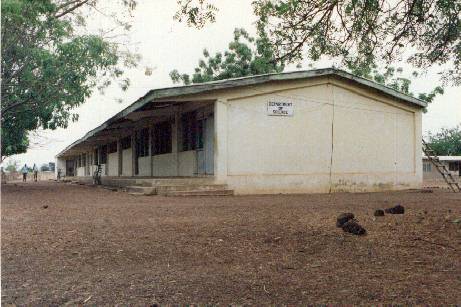| <=
|
 |
=>
|
| <=
|
 |
=>
|
The science lab is used for physics, biology and chemistry classes and practicals. It is typical of class room architecture not just in the north, but throughout Ghana. Our lab had louvred windows, but many classrooms have only shutters. This arrangement, especially in the north, is fine for the majority of the year when it doesn't rain. However, it's more of a problem during the heavy rainstorms of the wet season as classes have to be abandoned. Even if there were proper payned windows, the noise of the rain hitting the steel roof is so loud, the teachers can't be heard anyway.
The ladder on the right of the picture is used by students to carry buckets of water upto the water tank which supplies running water to the individual labs. Practicals requiring light or electricity were carried out during the evenings if the town generator was running. Due to its age and the load from the abundance of freezers in the town used to make 'ice water' or chill bottled beer, most houses - the school included, got 'lights' just twice a week between 6 and 10pm. The rest of the classrooms had some lighting, so during these days students could study in good light. On other days, a master on night duty would be met with a hundred or so yellow flickering kerosene lamps providing feeble light by which to study after darkness fell at 6pm.The school had a 1969 Lister diesel generator, which had seen far better days, but when the sound of the school generator starting up was heard and the light bulbs were illuminated a few seconds later, the students would give a huge roar of excitement!
When I left Ghana late 1998, work was well underway to extend the national grid from the regional capital, Wa. When this was completed people in Lawra hoped to get '24 hour' lights. However, rationing of the power from the national grid was extensive in 1998 due to the falling water level in the Volta lake which provides over 80% of Ghana's electricity supply.